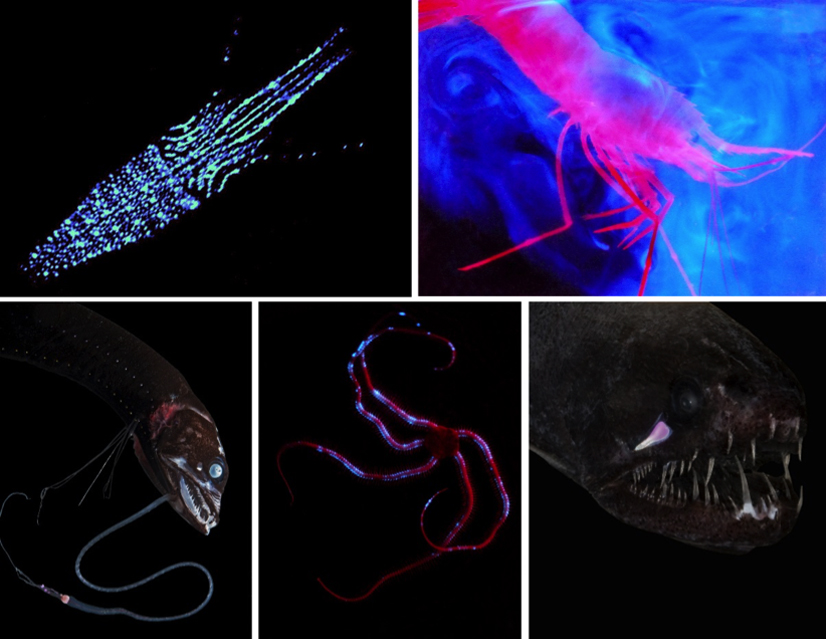Topic
Bioluminescence

Bioluminescence Fact Sheet
Bioluminescence is light produced by a living organism and is one of nature’s most amazing phenomena. It can seem more like science fiction than science!
Bioluminescence is a form of chemiluminescence, which is the production of visible light by a chemical reaction. Scientists call the process “bioluminescence” when the reaction occurs in living organisms. Bioluminescence is usually blue or blue-green. But it can be nearly violet (bright purple), green-yellow, and less often, red.
How Common is Bioluminescence?
While rare in ecosystems on land, bioluminescence is common in the marine environment. Many types of marine life, from bacteria, to squid, to fish, include some bioluminescent species. Scientists have found bioluminescent creatures from the ocean surface to the deep-sea floor.
How is Light Created?
Like with fire, a chemical reaction using oxygen also causes bioluminescence. However, the reaction occurs without giving off much heat. Instead, almost all of the energy is released as visible light.
Bioluminescence is an enzymatic reaction. An enzyme speeds up the chemical reaction by helping a substrate react. The enzyme is reused in the reaction instead of being transformed into another molecule.
The enzyme in bioluminescent reactions is luciferase. The different substrates are called luciferins. Luciferase helps catalyze, or speed up, the chemical reaction between the luciferins and oxygen. During this chemical reaction, the luciferin molecule is oxidized, which forms light and a new molecule, oxyluciferin, which is inactive. After the chemical reaction, luciferase is recycled, which means it can continue to produce light in the form of bioluminescence so long as both luciferin and oxygen are present. This reaction can take place within an organism or in the water.
In bioluminescent shrimp that spew light, the reaction happens outside the organism. In some animals, the reaction occurs in its cells. In others, it is produced by bacteria living in the organism. Yet, the same basic reaction between an enzyme and a substrate creates the light. Different species of organisms use different luciferin molecules. This suggests that the ability to make light evolved in different creatures at different times.

Survival in the Deep Ocean
Deep-ocean environments are almost completely dark. From 200 meters down to 1,000 meters deep is called the Twilight (or Dysphotic) Zone, where light decreases rapidly with depth. The area below 1,000 meters is called the Midnight (or Aphotic) Zone due to the complete lack of light there. Yet, organisms at depth prove that light is still important for survival. In fact, scientists estimate that more than 75% of the animals that live in the water column in the open ocean produce their own light!
Glowing Adaptations
Scientists do not yet understand the full purpose or function of this specialized adaptation or how it evolved. But bioluminescence can help organisms:
- Locate food
- Defend against or warn predators
- Hide from predators
- Attract or detect prey
- Attract mates
- Communicate

Vampires, Burglar Alarms, and More!
Like the fictional vampire Count Dracula, the vampire squid lurks in the dark. It is covered in light producing organs called photophores used to create a disorienting display of light to distract possible attackers.
Some species of squid and deep sea fishes have photophores concentrated on the underside of their bodies. Scientists believe this helps to make the animals less visible to predators viewing them from below as the light blends in with the speckled, dim light from above. This form of camouflage is called counter-illumination.
The Atolla wyvillei jellyfish defends itself from predators by flashing a bright ring of light. Scientists think this jelly’s “burglar alarm” light display serves to attract predators that eat the jelly’s own attackers!
Some species, like the deep-sea pandalid shrimp, Heterocarpus ensifer, can actually ‘vomit’ light from glands located near its mouth! This is thought to distract predators and allow the shrimp a quick getaway.
A few animals, such as anglerfish, grow bioluminescent bacteria in special light organs. In this symbiotic relationship, the fish supplies the bacteria with nutrients and the bacteria provide the fish with light needed to attract prey.
Unsolved Mysteries
Much about bioluminescence remains a mystery. Part of the challenge is that bioluminescent organisms in the ocean are difficult to observe and many types of bioluminescence cannot be seen under ordinary visible light. Thus, bioluminescence is a subject ripe for new discoveries!
ADDITIONAL RESOURCES
TO LEARN MORE ABOUT BIOLUMINESCENT ORGANISMS AND THEIR ADAPTATIONS, VISIT:
Light in the Deep Sea with Dr. Edie Widder (video)
Bioluminescence (Bonus 2) (video)
Fishes of the Midnight Zone
Bioluminescence Background